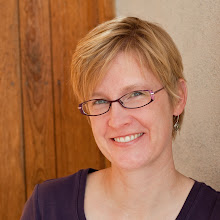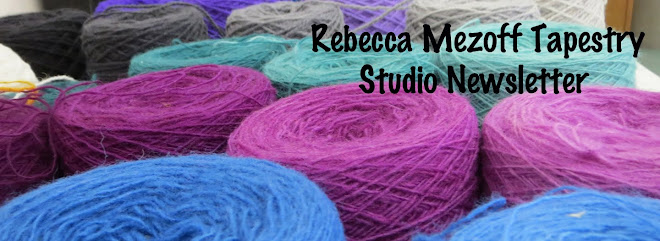I have had a few experiences lately that have led me to believe that I weave tapestry differently than most people. This is honestly a somewhat new revelation... perhaps born of denial. I weave from the back, which in itself might be acceptable considering all the French tapestry weavers who also do this, but I also weave on a floor loom largely from side to side. By that I mean that I weave all the way across the fell line and beat with a the beater on the loom.
I can just hear the lot of you gasping in horror. Yes, what I mean is that I weave one. pick. at. a. time. All the way across.
It was a conversation I had recently with
Susan Martin Maffei that sparked this particular thought jungle. Susan was in Santa Fe in June after teaching a class in Albuquerque. She gave a lecture titled
Under the Influence or Is It Just Inspiration? in which we learned a lot about her process and how her work has evolved over her career. (If you don't know Susan's work, please go to
her website right now and take a look. But don't forget to come back here!) I found Susan fascinating and wished her talk was hours longer than it was. She has woven on all kinds of looms in all sorts of orientations (front, back, low warp, high warp) and studied in France including at the
Gobelins. She has studied many kinds of textiles including pre-Columbian, her partner is Archie Brennan whom she collaborates with frequently, she teaches and lectures frequently, and her work is quite fascinating. She currently weaves on scaffolds, moving her body up the piece so she can see the whole thing instead of rolling the tapestry in any way. And she weaves large complicated pieces without any sort of cartoon at all.
She has done a series of narrative tapestries which you can
see on her website which include a piece called
Morning Walk & River Tides, 12 inches tall, 19 feet long. This piece includes quipus which indicate the time of high and low tide. Susan also talked a lot about the marks of tapestry and taking into account the medium when creating. She talked some about her sett (6 to 10 epi) and how working at a coarser set forces you to work with the marks of tapestry and get in touch with tapestry as a medium instead of a way of reproducing something. I am definitely on board with this line of thinking and hope to explore it even more in my next series of work.
A few days after Susan's talk there was an opening in the studio of a local artist and I was able to go and see some of her work. Due to some unavoidable circumstances involving a job, I was quite late. Luckily for me, most of the other guests had left and I had a chance to talk to Susan. Because James Koehler was my mentor and she knew him, we talked some about him. She had mentioned in her talk that tapestry was all about building up little areas of color to make an image. James did not do this. He wove all the way across the warp one pick at a time and beat with the loom beater.
So then I went to the Pacific Northwest and spent a lot of time with weavers from that part of the country include a good studying of the
Tapestry Artists of Puget Sound show (which you can see more about in
THIS blog post). Most of these weavers weave on an upright loom, from the front, with bobbins, building up little shapes. I was challenged in
Shelley Socolofsky's class to weave in this way (except for the bobbin part. That was asking just one bit too much.). And then I had some conversations with Mary Lane and Shelley about this. I watched Mary weave a little with her bobbins. I tried making little shapes out of my cartoon and building them up one at a time. And I realized that for this kind of image, weaving this way is much faster. There is much less picking up and putting down of tools and yarn.
Shelley talked some about the language of tapestry both in her lecture at the
Small Tapestry International 3 opening and in the
Traces workshop. Her class brought up again many questions for me about what can be said with traditional tapestry considering the existence of jacquard weaving. And coming from what both Susan and Shelley had said, my own questions about creating while considering the medium of tapestry and its (considerable) constraints.
I have been thinking about this for a few weeks now. Is my method of weaving really NOT tapestry? Well no. Is it traditional? Not in the medieval sense of tapestry, no. It is the tradition of the regional Hispanic weavers of New Mexico (though their techniques are different and I don't use them). I don't weave realistic images and I doubt I ever will. My work is somewhat driven by technique aimed at a certain effect and I can create that the easiest working from the back.
I think that what kind of image you are weaving should dictate the technique you are using. I really enjoyed weaving the sample in Shelley's class and intend to try weaving this way again if the image I am creating dictates that decision. I am excited to broaden my capabilities in various techniques. Am I going to change how I weave the current work I am doing? No. I feel that weaving broad color gradations that are climbing up the warp using continual hatching and color changes lends itself well to this "weaving all the way across" kind of work. And I frankly don't care if the purists tell me I am not weaving tapestry.
Here is the piece I am currently working on. The "gaspers" will be happy to note that I am going to use some eccentric weft and thus am building up some curves. Yes, I will have to use a hand beater. No, I will not be using bobbins.
Happy weaving! Feel free to share your thoughts on all of this in the comments below.










































